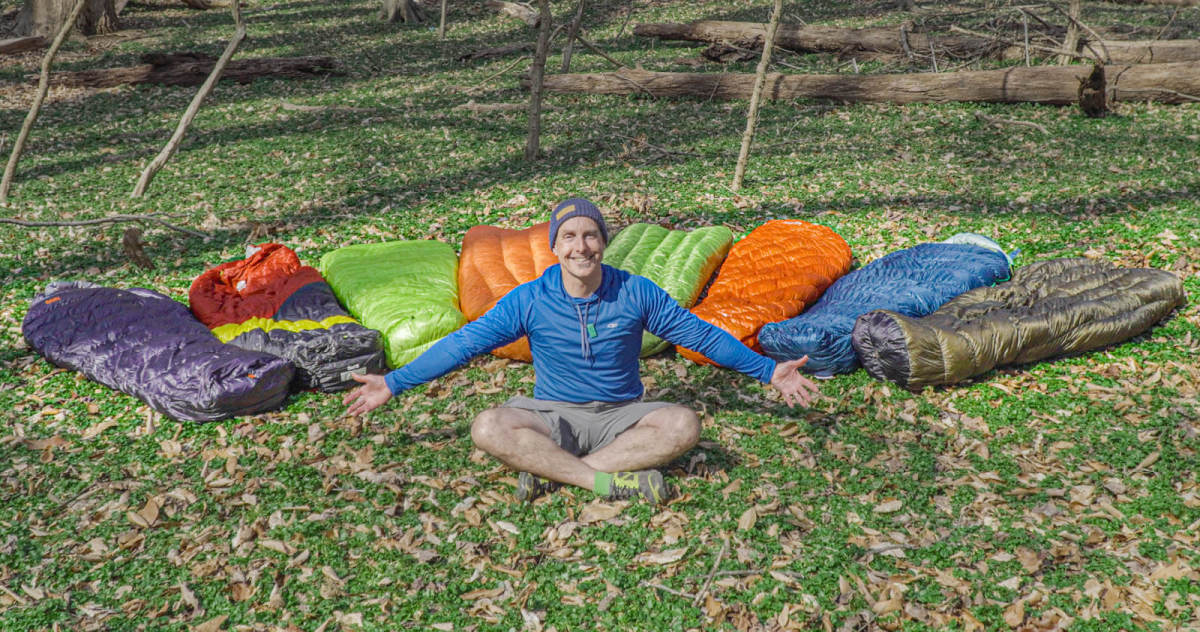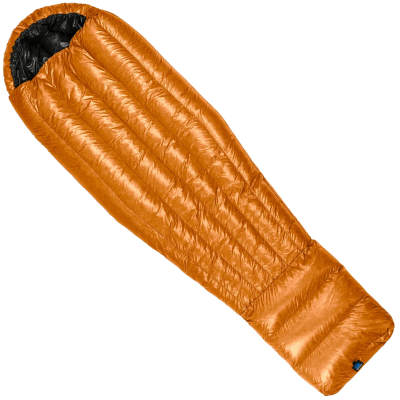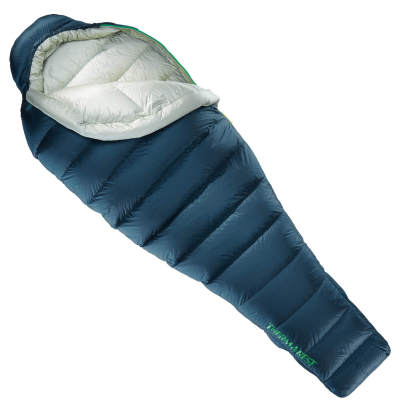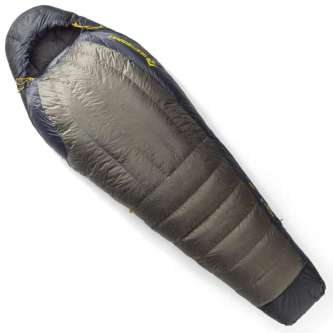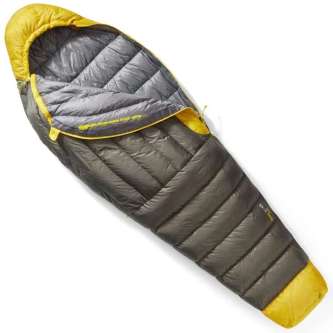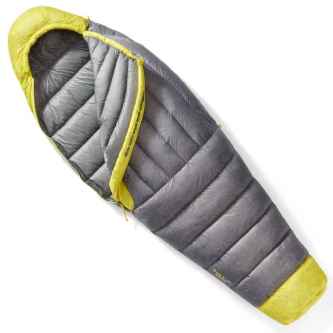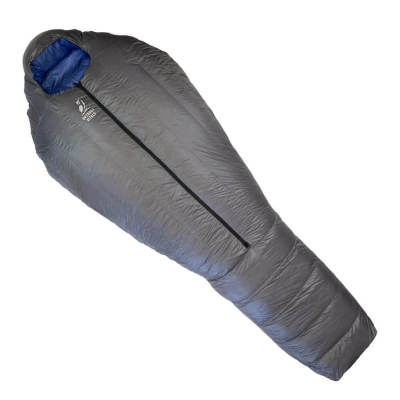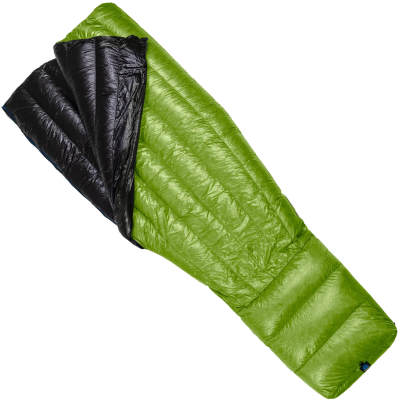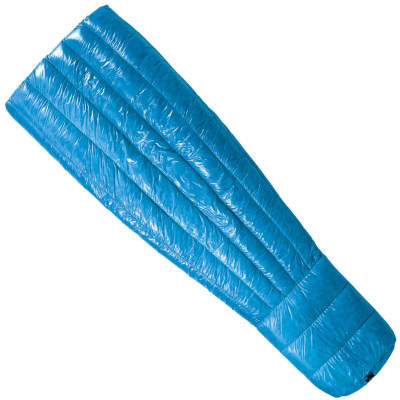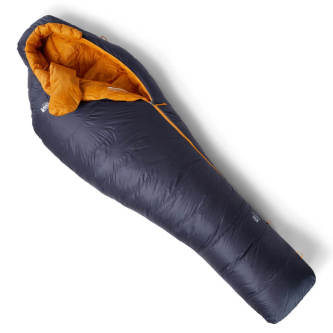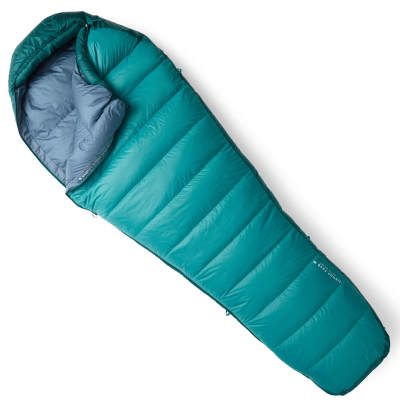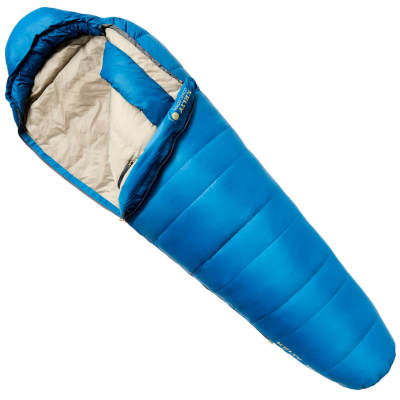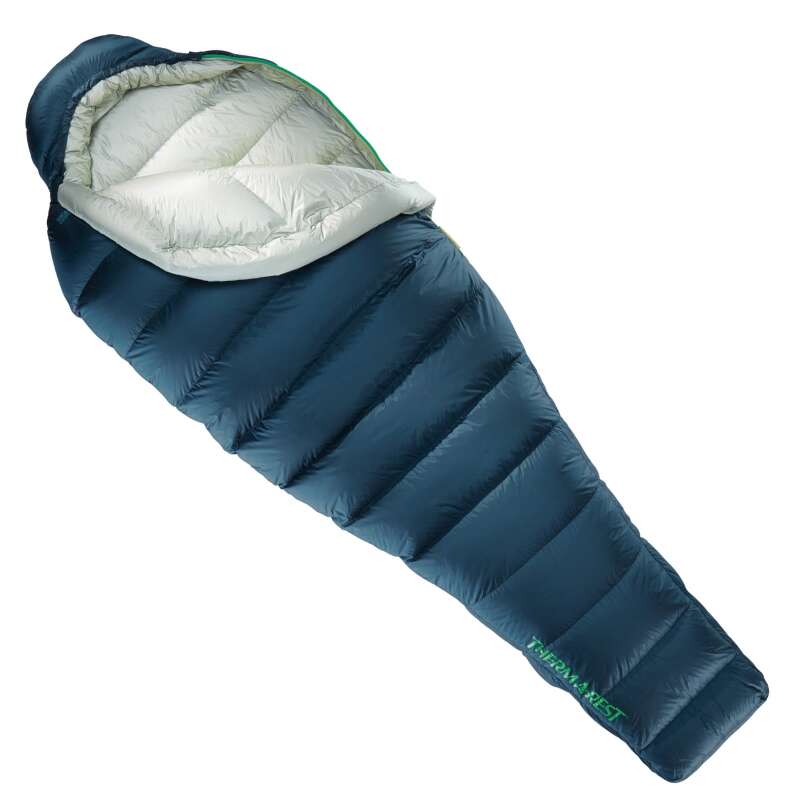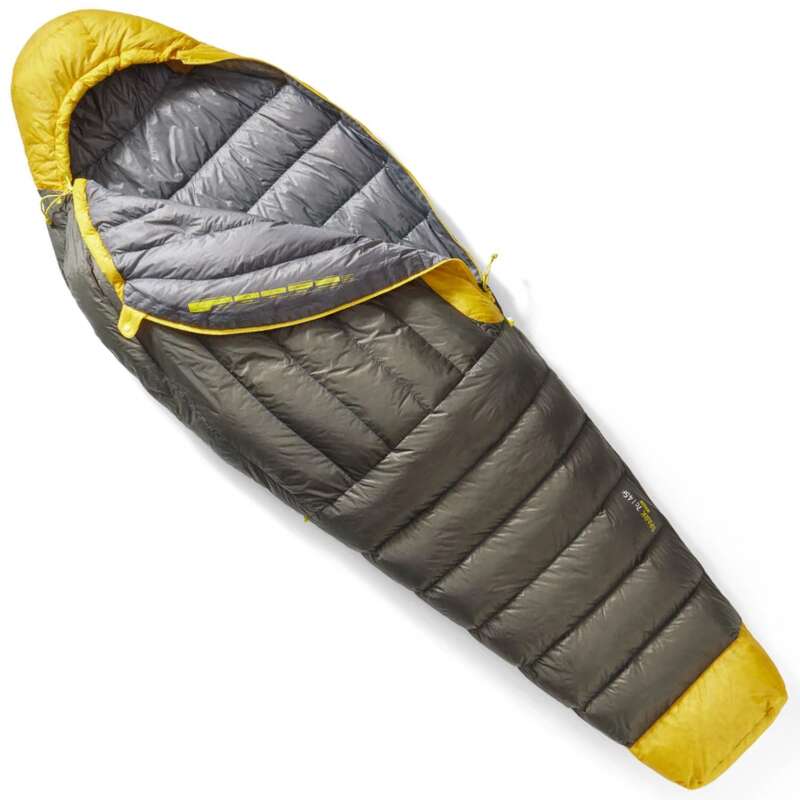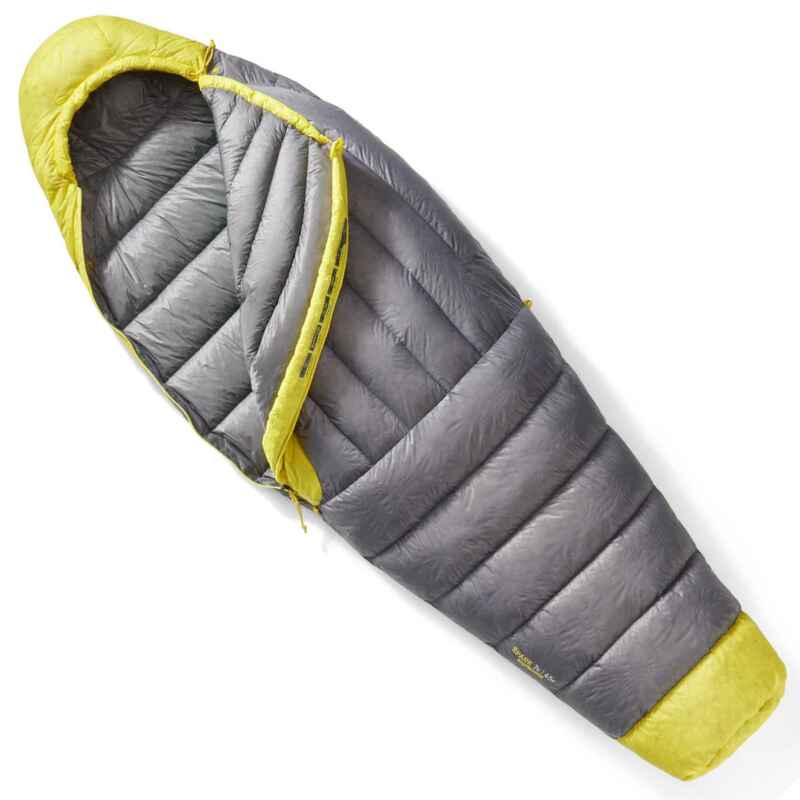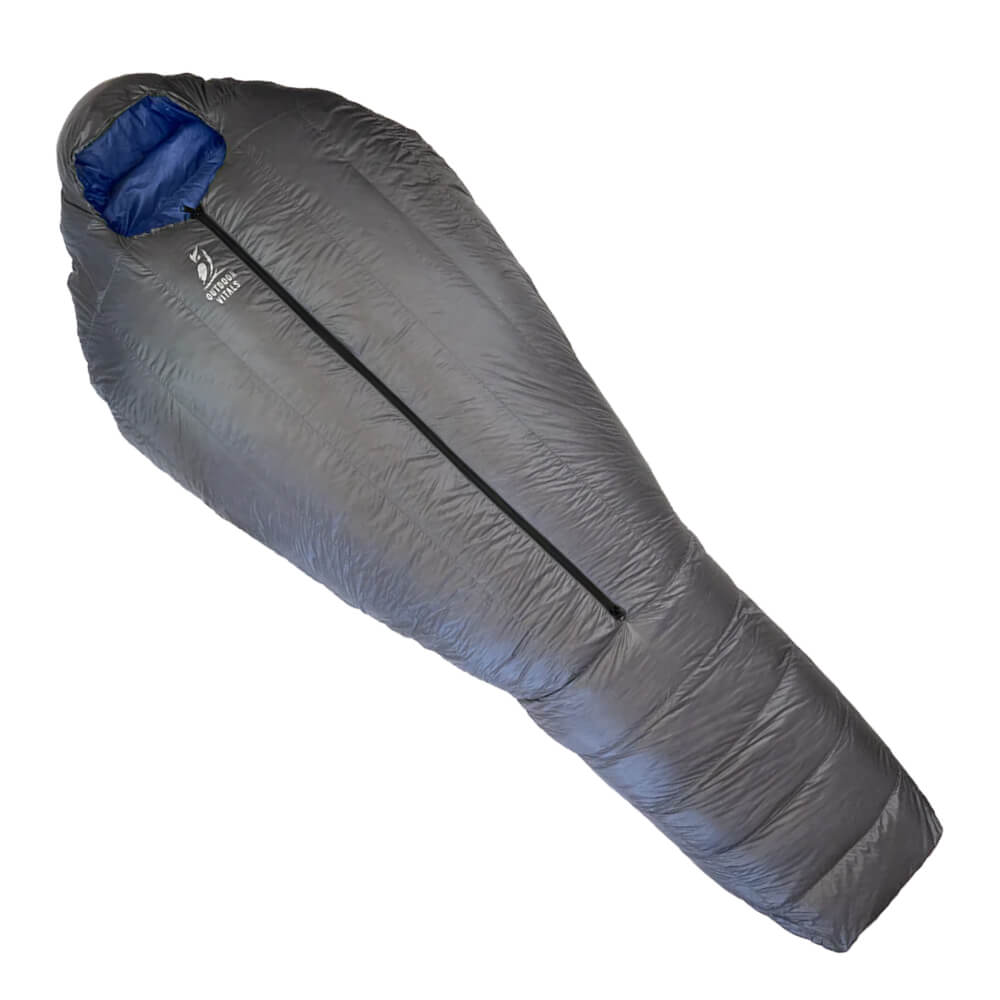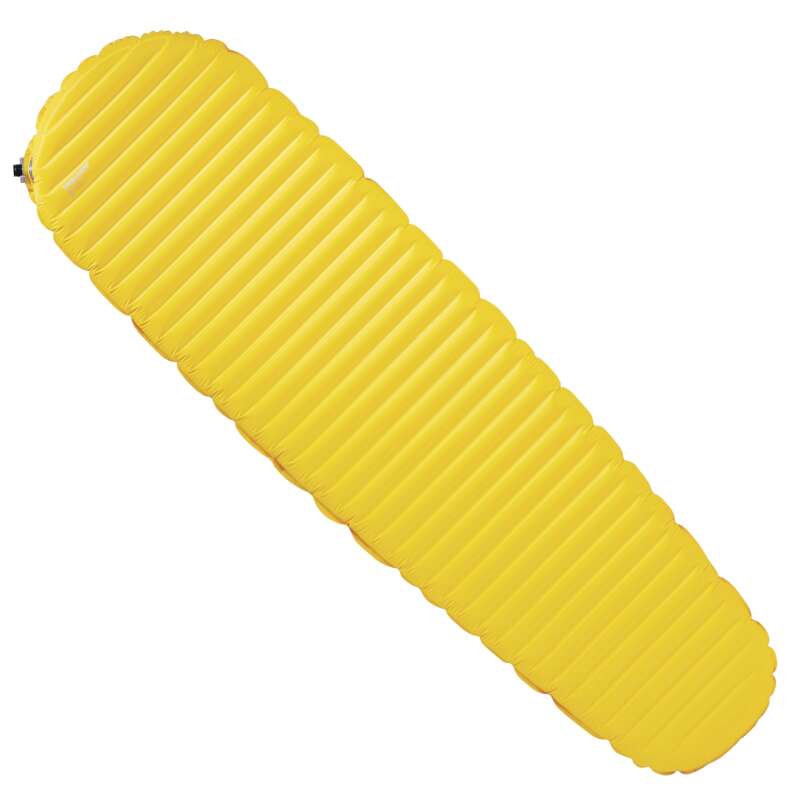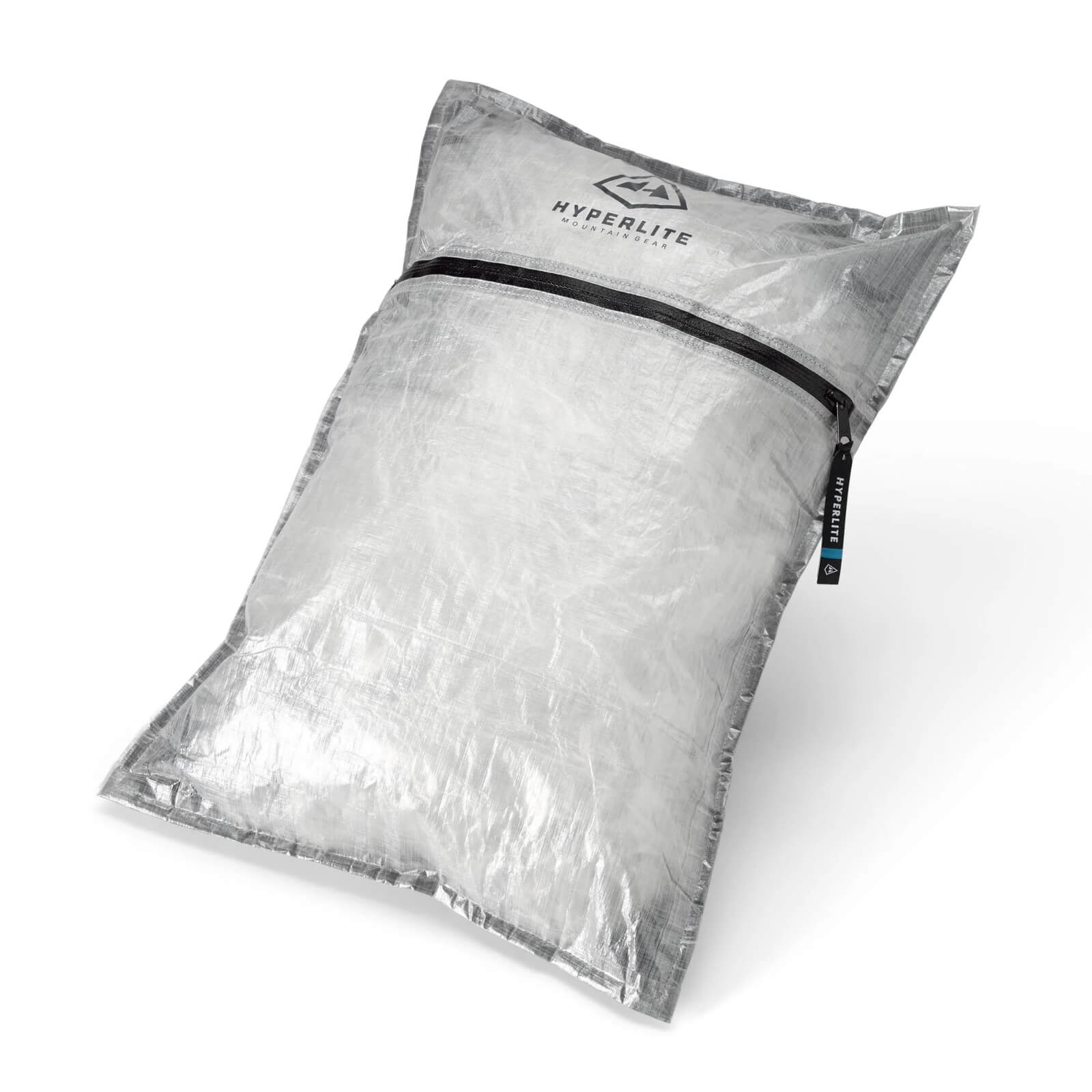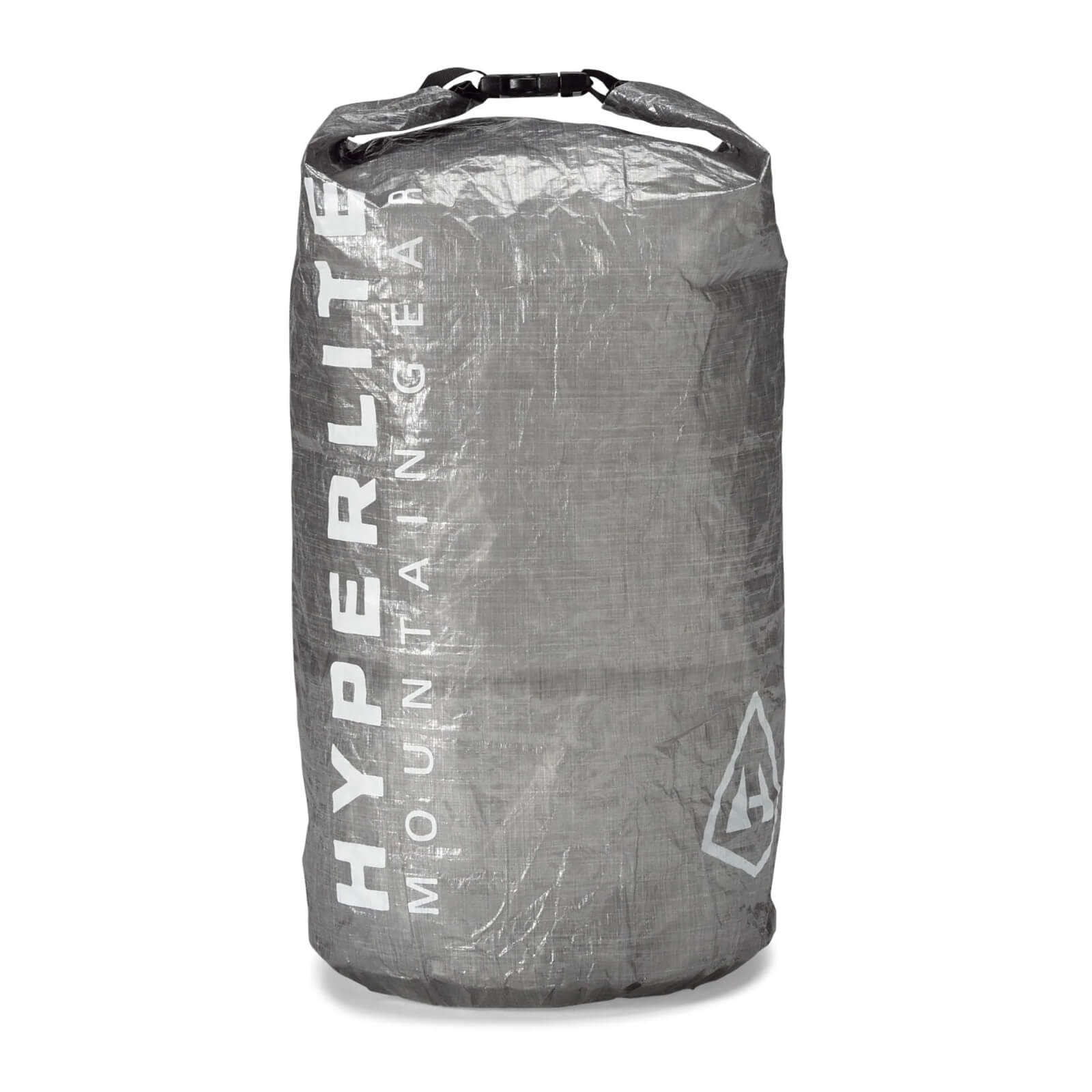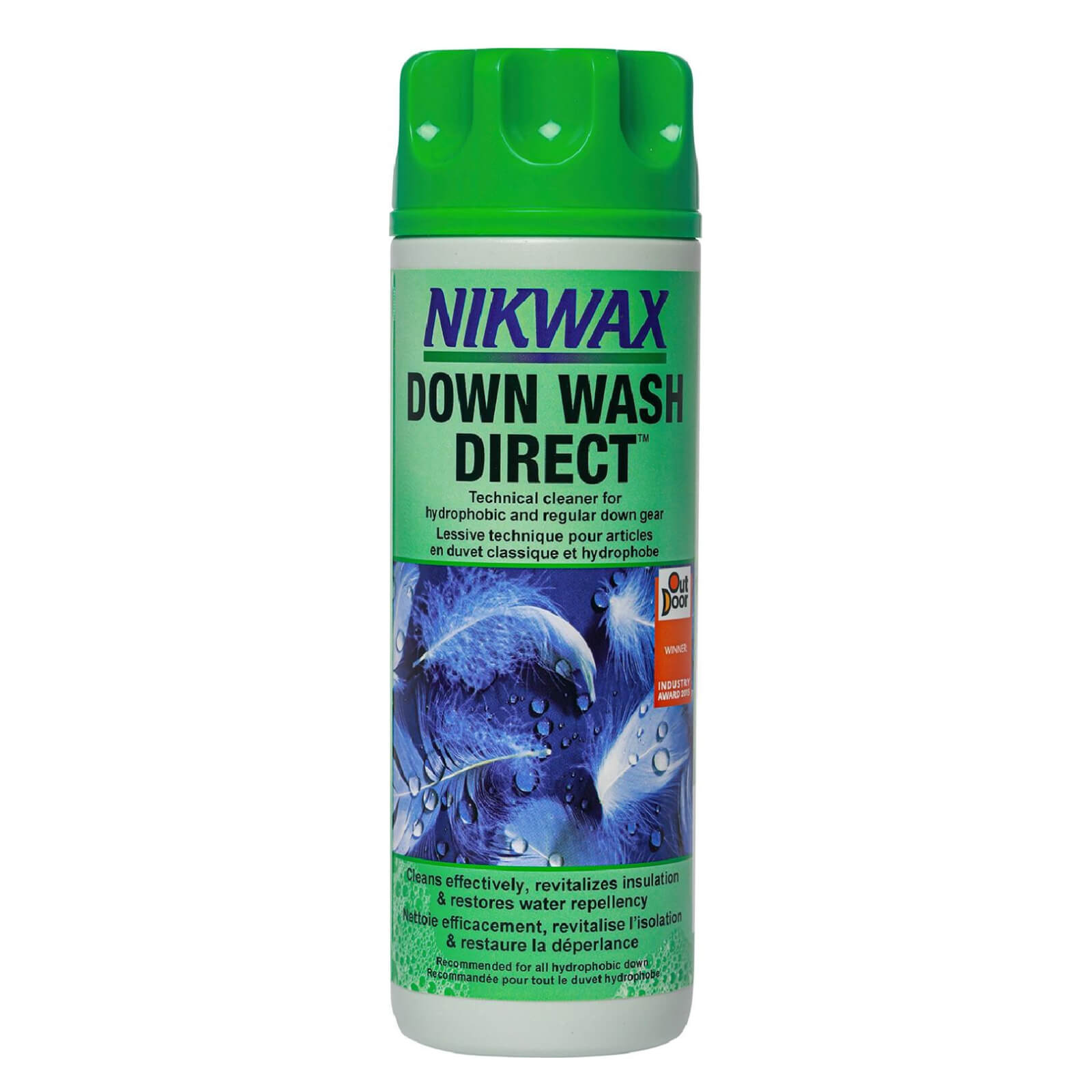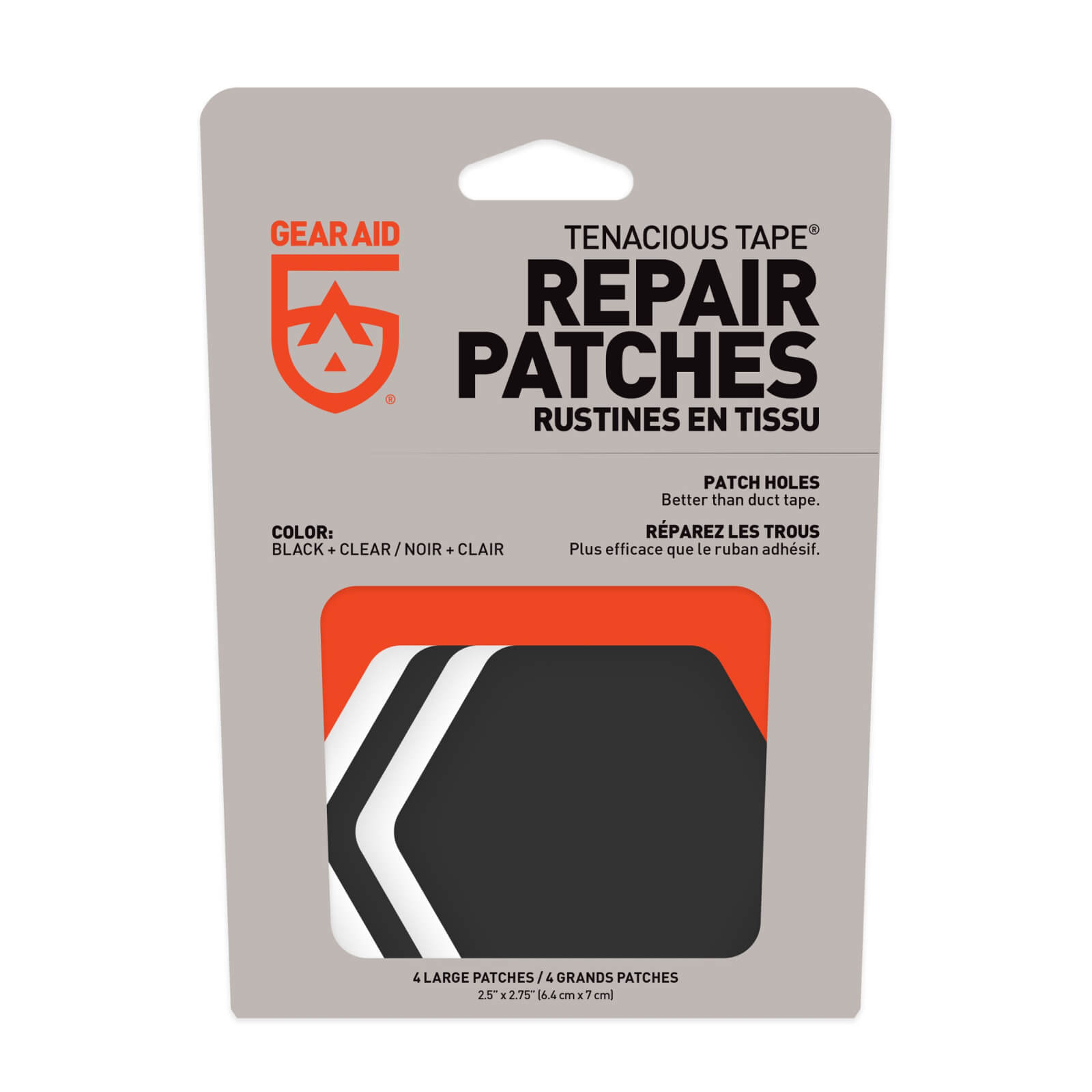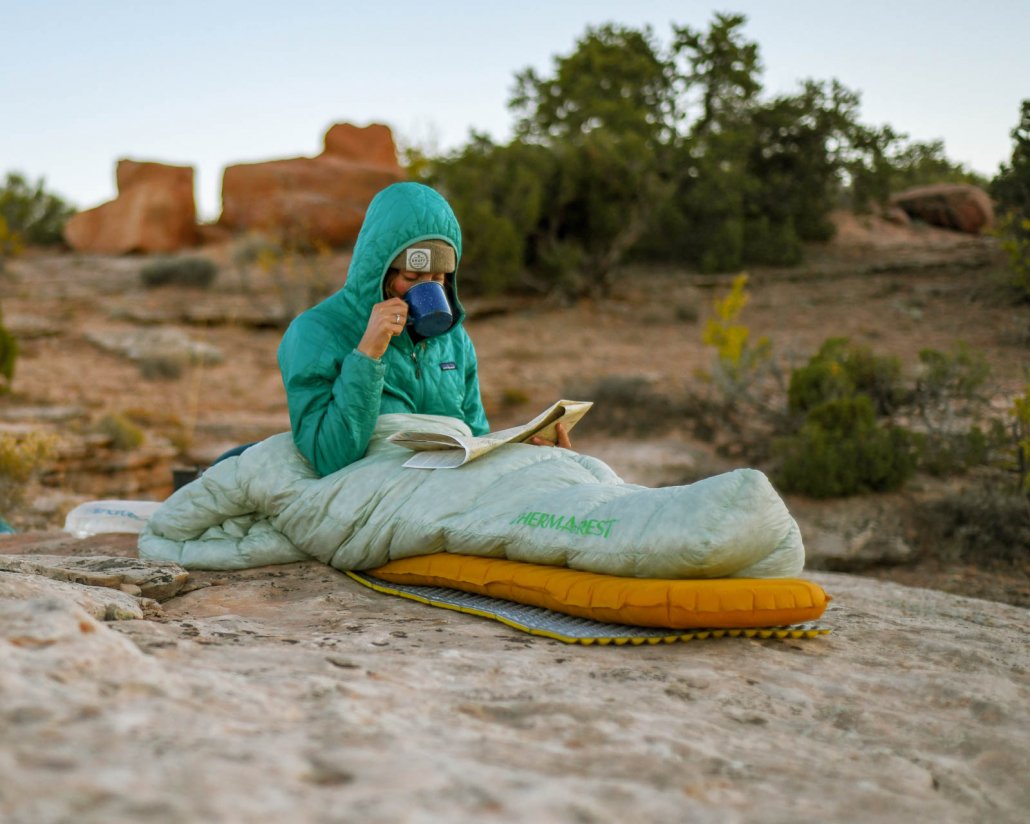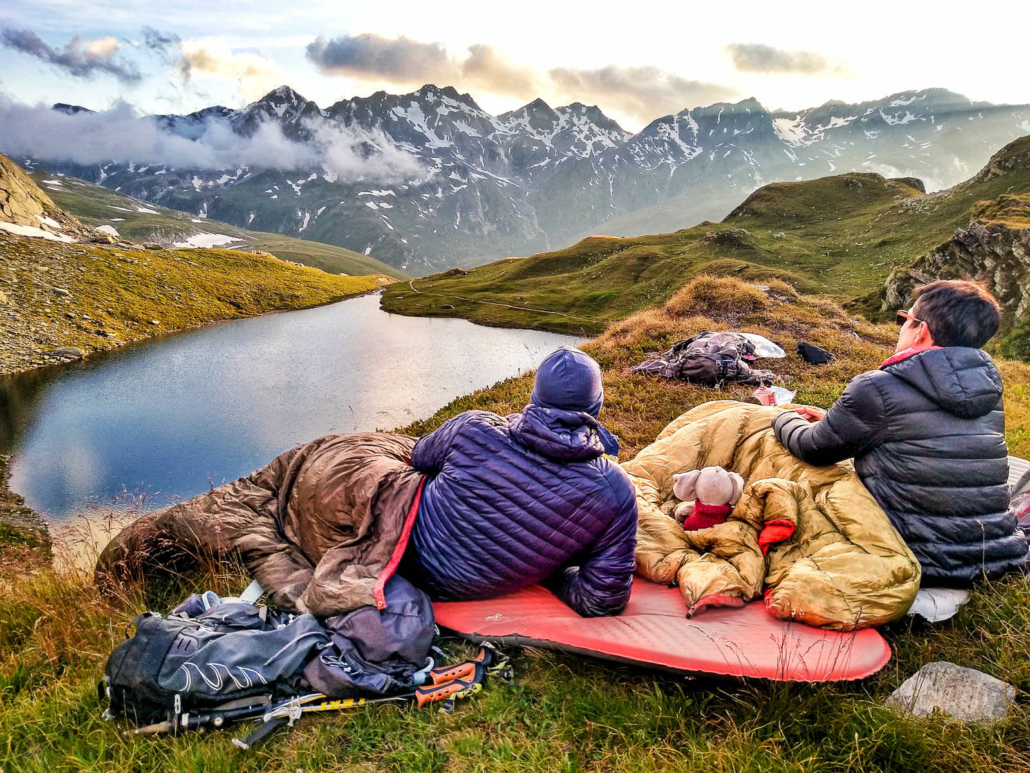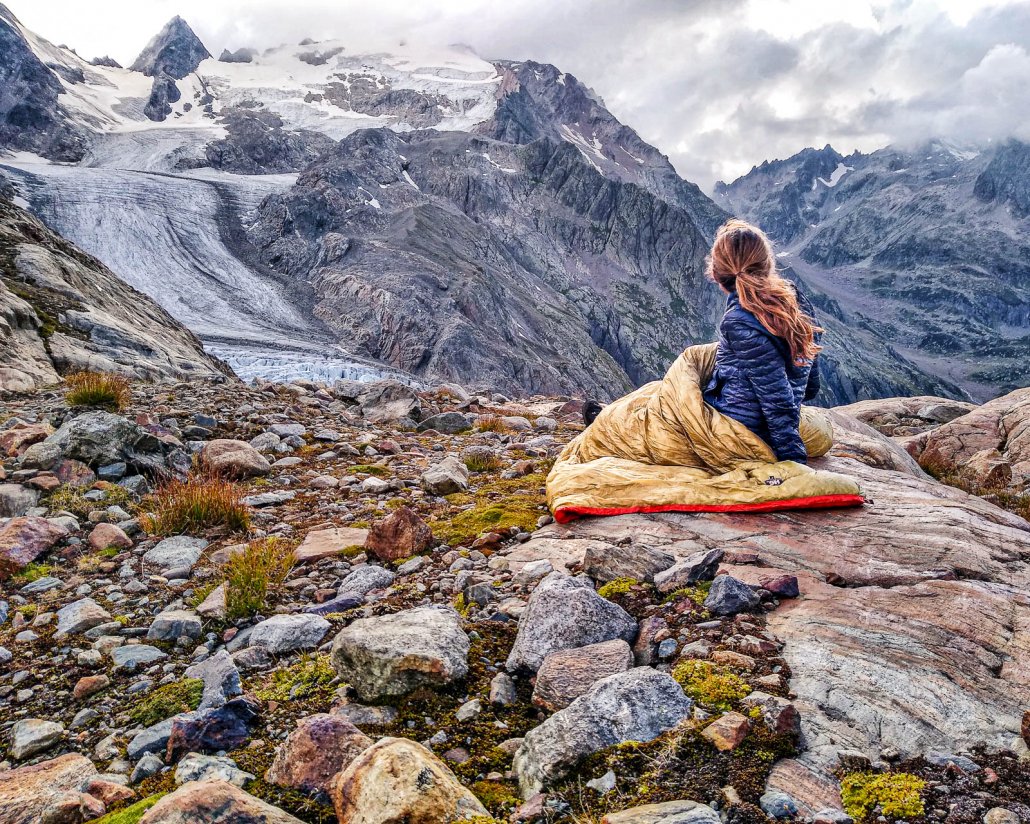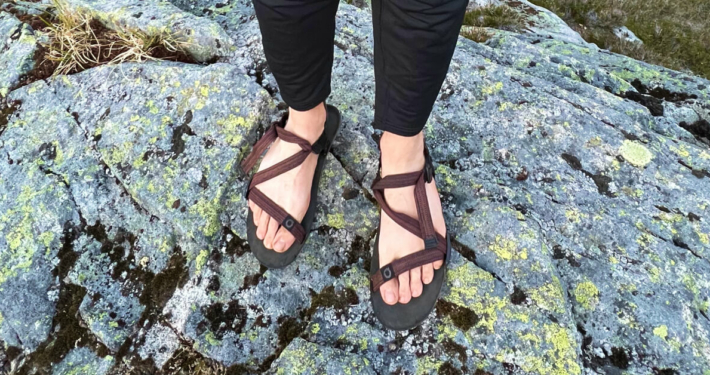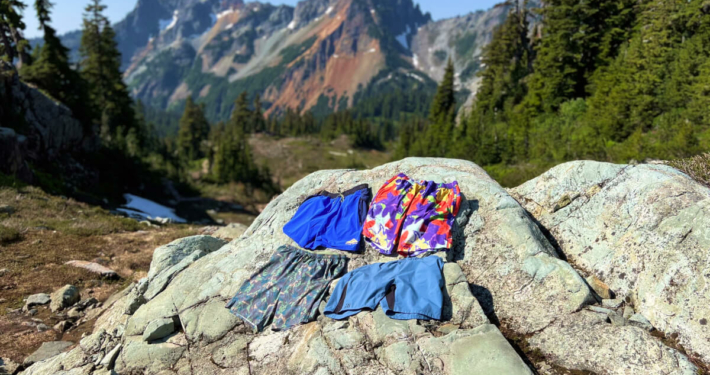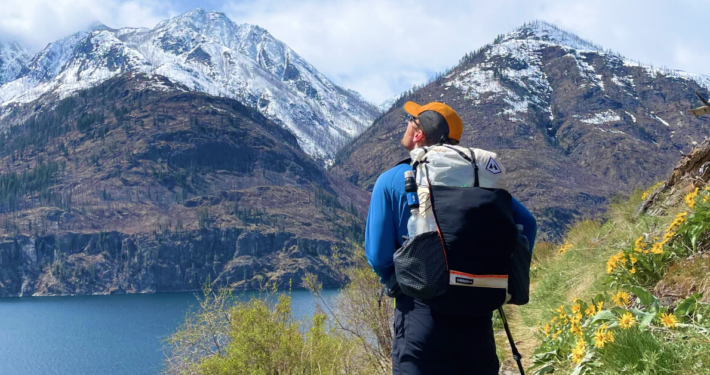Best Ultralight Sleeping Bag For Backpacking 2024
Last Updated: March 27, 2024
The highest warmth-to-weight ratio ultralight sleeping bags
This buyer’s guide to the best ultralight sleeping bag for backpacking focuses on models optimized for warmth-to-weight ratio. No gimmicks here. We pick sleeping bags that combine the lightest possible shell fabrics with the most down fill weight of the highest possible quality. An ultralight sleeping bag for backpacking allows you to hike more efficiently during the day, and recover comfortably at night.
Our assessments and recommendations are based on intensive product stat comparisons, backcountry testing, and decades of ultralight gear review savvy. We bring clarity to a marketplace clouded by deceptive temperature ratings and marketing hype to make sure you to get the best possible backpacking sleeping bag for your money!
Buying an ultralight sleeping bag for backpacking is a major investment, which is why we encourage you to keep reading past the reviews (or skip ahead) to learn more about our inclusion criteria, and buyer considerations. This guide is focused on models named 15-20F, which we feel is most universal, as they will keep you comfortable down to freezing.
Want to go even lighter? Check out our guide to hoodless, zipper-less backpacking quilts. And while you’re here, you may also be interested in our guides to ultralight pillows, dry bags, sleeping pads, backpacking tents, backpacking packs, or winter sleeping bags.
You make Adventure Alan & Co possible. When purchasing through links on our site, we may earn an affiliate commission at no additional cost to you. Here’s why you can trust us.
Quick Picks: Best Ultralight Sleeping Bags for Backpacking
- Best Ultralight Sleeping Bag: Zpacks Mummy 20
- Next Best Ultralight Sleeping Bag: Therm-a-Rest Hyperion 20
- Best Lightweight Sleeping Bag: Sea to Summit Spark Pro 15
- Next Best Lightweight Sleeping Bag: Sea to Summit Spark 15
- Best Women’s Specific: Sea to Summit Spark W’s 15
- Best Value: Outdoor Vitals Summit Down 15
- Best Convertible Quilt: Zpacks Zip Around 20
- Best Hoodless: Zpacks Classic 20
- Best Co-op Brand Model: REI Co-op Magma 15
- Best Under $300: Mountain Hardwear Bishop Pass 15
- Best Under $200: Kelty Cosmic 20
Best Ultralight Sleeping Bag Accessories
- Best Sleeping Pad: Therm-a-Rest NeoAir Xlite NXT
- Best Pillow: Hyperlite Mountain Gear Stuff Sack Pillow
- Best Dry Bag: Hypermite Mountain Gear Roll Top Stuff Sack
- Best Down Wash: Nikwax Down Wash Direct
- Best Repair Patch: Gear Aid Tenacious Tape Repair Kit
Best Backpacking Sleeping Bag Comparison Table
Mobile users rotate device for full-width table
| Sleeping Bag | Price ($) | Weight (oz) | Fill Power (in³) | Fill Weight (oz) | Down Volume (in³) | Down Vol/Total Weight (in³/oz) |
| Zpacks Classic 20 | 449 | 18.8 | 900 | 13.7 | 12330 | 656 |
| STS Spark W 15 | 549 | 32.8 | 850 | 24.2 | 20570 | 627 |
| Zpacks Mummy 20 | 539 | 23.2 | 900 | 15.6 | 14040 | 605 |
| Zpacks Zip Around 20 | 479 | 21.6 | 900 | 14.5 | 13050 | 604 |
| STS Spark Pro 15 | 649 | 27.7 | 950 | 16.9 | 16055 | 580 |
| Therm-a-Rest Hyperion 20 | 549 | 20 | 900 | 12.5 | 11250 | 563 |
| STS Spark 15 | 549 | 25.7 | 850 | 16.9 | 143656 | 559 |
| REI Co-op Magma 15 | 429 | 35.6 | 850 | 23.3 | 19805 | 556 |
| OV Summit Down 15 | 375 | 29 | 800 | 19.4 | 15520 | 535 |
| MH Bishop Pass 15 | 285 | 37.4 | 650 | 22 | 14300 | 382 |
| Kelty Cosmic 20 | 165 | 42 | 550 | 16.4 | 9020 | 215 |
Best Ultralight Sleeping Bag
Zpacks Mummy Sleeping Bag 20
The Zpacks 20F Mummy Sleeping Bag is our pick for the singular best sleeping bag for backpacking with the highest performance, traditional-style chassis in terms of warmth-to-weight ratio. This is a true ultralight sleeping bag, and top notch materials keep the weight to only 23.2 oz. Read more in our full-length Zpacks Mummy Sleeping Bag Review.
- Weight: 23.2
- Price: $539
- Down: 900 fill power RDS hydrophobic goose down
- Fill Weight: 15.6 oz
- Fabric: 7D Ventum Ripstop Nylon
- Down Vol: 14040 in³ | Down Vol/oz: 605 in³
- Estimated Comfort: +25 F
- Pros: Ultralight. High warmth-to-weight. Converts to blanket.
- Cons: Expensive. Slightly delicate.
Construction & Features
It’s constructed with 7D Ventum ripstop nylon which is comfortable, breathable, wind/water resistant. We find it’s durable enough for most backcountry use. Its baffles are overstuffed (by 30%!) with 900 fill power RDS hydrophobic goose down. Overstuffing reduces cold spots due to down drift, and is a very desired feature that adds minimal weight.
It’s even protected from snagging on its own zipper by the full length zipper guard. But like most ultralight sleeping bags, it’s a bit more delicate than average. Handle with care and it will last many years.
On colder nights, we love cinching down the hood to stay cozy, and on warmer nights, we love how it can fully unzip and convert into a blanket for better ventilation. Or just zip open the footbox to add airflow. It is available in three lengths (short, medium, long) and two widths (standard, broad) to accommodate a wide variety of bodies.
We have zero major knocks against this excellent product and feel it raises the industry-wide bar for backpacking sleeping bag performance.
Verdict
It’s as simple as this. If you want the best sleeping bag for backpacking that money can buy, choose the Zpacks Mummy 20.
Second Best Ultralight Sleeping Bag
Therm-a-Rest Hyperion 20
We value warmth-to-weight above all else in an ultralight sleeping bag for backpacking, which is why we like the Therm-a-rest Hyperion 20. Based on our estimation, it has one of the highest warmth-to-weight ratio of any conventional 20F ultralight sleeping bag from a mainstream outdoor gear brand. It’s only bested by designs from ultralight cottage industry brands like Zpacks.
- Weight: 20.0 oz
- Price: $550
- Down: 900 fill power hydrophobic goose down
- Fill Weight: 12.5 oz
- Fabric: 10D Nylon Ripstop
- Down Vol: 11250 in³ | Down Vol/oz: 563 in³
- ISO Tested Comfort: +32 F
- Pros: Ultralight. High warmth-to-weight.
- Cons: Expensive. Narrow. Slightly under-filled. Horizontal baffling on torso.
Construction & Features
This is achieved through the use of 900 fill power down, in conjunction with a relatively lightweight 10D shell fabric, and a snug fit. Additionally Therm-a-rest also states that they have intelligently distributed the down. In this ultralight sleeping bag, 70% of the plumes are in the top section where it works harder to insulate rising heat.
Prioritizing the top insulation and de-prioritizing the back is quilt-like in its design mentality, and we think it’s a cool and innovative choice. We believe that is at least part of what allows Thermarest Hyperion 20F to be lighter than almost all similarly comfort temp rated bags. But it likely requires a high R-Value sleeping pad, like the Therm-a-Rest NeoAir XLite NXT.
As you can see in the photo, Hyperion has a pretty slim design, and an exceptionally small footbox. While decreasing interior volume decreases comfort, it increases warmth. Heat radiating off one’s body is condensed throughout a smaller total space, rather being distributed and diluted.
In this case, our modeling agrees with ISO that this bag is comfortable down to 32 degrees and think it will handle most 3-season backpacking conditions with aplomb. However, if you run cold, you consider a bag with a slightly lower comfort rating.
Verdict
The Them-a-Rest Hyperion 20F is a narrow mummy, but otherwise an incredible backpacking sleeping bag, and will serve ultralight backpackers very well.
Best Lightweight Sleeping Bag
Sea to Summit Spark Pro
The new Sea to Summit Spark Pro 15 Down Sleeping Bag is the performance optimized version of the brand’s flagship Spark sleep system. It is generously filled with top tier 950 fill power down and can even be converted into quilt-mode. The key takeaways are that this is an overall great lightweight sleeping bag, made with excellent materials, and conservatively temperature rated, despite the fact that it would have had a higher warmth-to-weight ratio without all of the quilt conversion/venting zippers.
- Weight: 27.7
- Price: $649
- Down: 950 fill power RDS Ultra Dry down
- Fill Weight: 16.9 oz
- Fabric: 10D nylon
- Down Vol: 16055 in³ | Down Vol/oz: 580 in³
- Estimated Comfort: +15 F
- Pros: Lightweight. Generously filled with very high quality down. Could have been named Spark Pro 10. Versatile.
- Cons: Very expensive. Overly featured. Not quite ultralight.
Construction & Features
Starting with the materials, we really like what the Sea to Summit Spark Pro Sleeping Bag has going on. Its 950 fill power RDS certified down is top shelf and totally best in class. Most high end sleeping bags utilize 850, or 900 fill power, which leaves Spark Pro a cut above. Furthermore, its baffles are generously filled, which makes for a conservative temp rating – we haven’t tested it in conditions this cold, but you likely could sleep comfortably in 15F degrees in the Spark Pro 15. Likely nobody would have batted an eye if they decided to call it the Spark 10.
We also appreciate the use of 10d nylon shell fabric, which saves weight while still offering sufficient durability and comfort. Many mainstream outdoor brands of comparable size to Sea to Summit shy away from thinner shell fabrics, instead opting for 15d or 20d, and thus catering to the lowest common denominator who are more likely to damage their bag. Not so here.
There’s lots of little design touches that make this a great sleeping bag. We nod to the mixed baffles orientation which prevents down drift and cold spots, especially for side sleepers. Also the draft tube, and zipper plow, which seems to never get stuck.
Perhaps the most interesting aspect to the Spark Pro design is the Free-Flow Zip. This network of zipper tracks allows for highly customizable ventilation and even wear-ability. The primary zipper runs on the wearer’s left side from shoulder to knee, and is used for entry/exit, as well as side ventilation. A second zipper track runs from knee downwards and traces the footbox. This allows for foot ventilation on warm nights. Open both of those zippers and you can convert the Spark Pro into a pseudo quilt. A short zipper track located at the right shoulder can be opened allowing the user to stick both arms out while keeping their torso warm.
While the aforementioned zippers do add versatility and massive ventilation capabilities, they also add significant zipper weight, a bit of cold spotting (despite interior zipper insulated flaps), increased cost, more avenues to potential gear failure, and ultimately decrease warmth-to-weight ratio. As such, we view the Free-Flow Zip system as a net negative that degrades the efficacy of the sleeping bag for more ventilation than is necessary and a quilt-mode that people probably won’t use. Or if you do intend to use quilt mode, just buy a quilt instead.
Verdict
The Sea to Summit Spark Pro is an excellent sleeping bag with excellent down fill, but made heavier, pricier, and ultimately slightly worse by an array of zippers for ventilation and quilt-conversion that we don’t want and didn’t ask for. We repeat, this is a great, albeit expensive, sleeping bag. It’s just disappointing that it could have earned an A, but tried to be fancy and instead earned an A-.
Second Best Lightweight Sleeping Bag
Sea to Summit Spark
Redesigned and rereleased for 2024, the Sea to Summit Spark 15 Sleeping Bag is as good as ever. This is a classic ultralight bag made with a 10d shell/liner fabric and 850 fill power down for a high warmth-to-weight ratio. It’s simple, effective, top tier, and ready to keep you toasty warm.
- Weight: 25.7 oz
- Price: $549
- Down: 850 fill power RDS Ultra Dry down
- Fill Weight: 16.9 oz
- Fabric: 10D nylon
- Down Vol: 14365 in³ | Down Vol/oz: 559 in³
- Estimated Comfort: +20 F
- Pros: Ultralight. Minimalist feature set. Good warmth-to-weight ratio.
- Cons: Expensive. Heavy end of ultralight. Temp rating is a bit generous.
Construction & Features
Starting with the insulation and using the the 15F configuration for sake of discussion, you get 16.9 oz of 850 fill power RDS-certified dry down. In context of the greater marketplace, 850 is great-not-excellent, but we’d have hoped for 900+ in a bag at this price point. That being said, 850 still performs very well and there’s lots of it. The quantity of down times the fill power yields a total insulation that’s greater than your average 20 degree bag, but less than your average 15F degree.
We also appreciate the use of 10d nylon shell fabric, which saves weight while still offering sufficient durability and comfort. Many mainstream outdoor brands of comparable size to Sea to Summit shy away from thinner shell fabrics, instead opting for overkill durability at 15d or 20d, and thus catering to the lowest common denominator who are more likely to damage their gear. Not so here!
There’s lots of little design touches that make this a great backpacking sleeping bag. We nod to the mixed baffles orientation which prevents down drift and cold spots, especially for side sleepers. Also the cinchable draft tube, and zipper plow, which seems to never get stuck. Lastly, its zippers can mate with the Women’s version to make a cozy 2P hybrid bag.
Verdict
Choose the redesigned 2024 Sea to Summit Spark for a great all-around ultralight sleeping bag. It has a high warmth to weight ratio, minimalist feature set (yes please!), and lots of nice design touches. Biggest drawback would be the use of 850 fill power down when we’d expect 900+ in a sleeping bag at this price point. All said and done, Spark remains one of the very best sleeping bags on the market.
Best Women’s Specific Sleeping Bag
Sea to Summit Spark Women’s
For a sleeping bag designed to accommodate cold sleepers and curvier bodies, choose the Sea to Summit Spark Women’s edition, updated for 2024 and previously referred to as “Flame.” This 15F version of this bag is ~40% warmer (and bulkier) than S2S’s unisex model of the same temperature rating, and in unisex rating terms, could have been called a 5F. It’s a great lightweight sleep system with high quality down fill and shell fabric, an exceptional warmth-to-weight ratio, and is the overall best women’s specific model on the market. Shop now.
- Price: $549
- Weight: 32.8 oz
- Down: 850 fill power RDS Ultra Dry down
- Fill Weight: 24.2 oz
- Fabric: 10D nylon
- Down Vol: 20570 in³ | Down Vol/oz: 627 in³
- Estimated Comfort: +15F for cold sleepers, +5F for warm sleepers
- Pros: Minimalist feature set. Exceptional warmth-to-weight ratio. Very warm. Conservative temp rating. High quality materials.
- Cons: Expensive. Bulky. Somewhere between lightweight & midweight.
Construction & Features
Physiologically speaking, women sleep slightly colder than men, which is why the Sea to Summit Spark Women’s sleeping bag is approximately 40% warmer than the unisex version of the same temperature rating. Comparing 15F rated bags, the W’s version has 20k in³ total down insulation volume, while the unisex has 14k. While 850 fill power down is overall high quality and compresses nicely, you can only do so much to minimize bulk.
This bag is also designed to fit women’s bodies. As such, Sea to Summit has widened the hips, narrowed the shoulders, and shortened the length. That beings said, it’s not drastically different from the unisex cut and we don’t see why a colder sleeper man couldn’t also use the w’s version.
Beyond the shape and increased down fill, Sea to Summit Spark Women’s is the same great bag as the unisex. We appreciate the use of 10d nylon shell fabric, which saves weight while still offering sufficient durability and comfort. Many mainstream outdoor brands of comparable size to Sea to Summit shy away from thinner shell fabrics, instead opting for 15d or 20d, and thus catering to the lowest common denominator who are more likely to damage their bag. Not so here.
There’s lots of little design touches that make this a great sleeping bag. We nod to the mixed baffles orientation which prevents down drift and cold spots, especially for side sleepers. Also the draft tube, and zipper plow, which seems to never get stuck. Lastly, its zippers can mate with the unisex version to make a cozy 2P hybrid bag.
Verdict
Cold sleepers will love the Sea to Summit Spark Women’s sleeping bag, which is temp rated extremely conservatively – it has enough insulation to justify a unisex 5F rating. The 850 power down is great-not excellent, and the 10d nylon shell is truly ultralight. All in all, this is a killer sleeping bag with an exceptional warmth to weight ratio and perfectly suited to cold sleepers. Our pick for best women’s specific model on the market.
Best Value Backpacking Sleeping Bag
Outdoor Vitals Summit Down Sleeping Bag 15
Choose the Outdoor Vitals Summit Down 15 for a very generously filled, warmer-than-average, less-expensive-than average, premium lightweight sleeping bag.
- Weight: 29.0
- Price: $375
- Down: 800 fill power hyperdry duck down
- Fill Weight: 19.4 oz
- Down Vol: 15520 in³ | Down Vol/oz: 535 in³
- Fabric: 10D Toray Ripstop Nylon
- Estimated Comfort: +25 F
- Pros: Lightweight. Generously filled. Warmer than average. Horizontal/vertical baffle split. Draft collar.
- Cons: Duck down is inferior to goose. Light not ultralight. Overfill increases bulk. Center creates minor cold spot issue.
Construction & Features
First thing first, this sleeping bag has more down stuffed into its baffles than you’ll find in most of its competitors at a similar temp rating And overfill is a good thing. It prolongs the ability of the baffles to loft as the plumes degrade over time with each compression cycle. Overfill adds only minimal weight, however, it definitely increases bulk.
Note, this is duck is duck down, not goose down. It doesn’t make a huge difference, 800 fill power is still 800 fill power. But duck down plumes are regarded as less durable, and smellier when wet. But generally speaking, it doesn’t matter much.
There are a few more notable features are worth calling out. The 3/4 length center zipper means lefties will never get hosed, but it may take some getting used to if you are coming from a side zipper. The obvious downside to center zippers is that they create a cold spot on the very top of the bag, not ideal. However, this comes with a boxed zipper baffle flap. This mostly reduces, but does not entirely eliminate the cold spot issue.
We also nod to the pillow-style draft collar baffles, which seal heat in at the face gap. You can get real cozy in this bag. They also note a differential cut, meaning the interior shell is smaller than the outer shell, which allows down to stay lofted as you move around inside and compress against the liner. Most premium sleeping bags have this, but it’s nice to see them spell it out for transparency.
Verdict
The value proposition on this lightweight sleeping bag is simply excellent. It’s warmer and less expensive than average, yet still lighter than most other options on the market.
Best Convertible Sleeping Bag Quilt
Zpacks Zip Around Sleeping Bag 20
If you’re willing to omit the hood, Zpacks Zip Around 20 will deliver the best backcountry performance in an ultralight sleeping bag. Without a hood, it is able to achieve the low low weight of only 21.6 oz, thus offering one of the highest warmth-to-weight ratios on the market. Read more in our full-length Zpacks Zip Around 20 Review.
- Weight: 21.6
- Price: $479
- Down: 900 fill power RDS hydrophobic goose down
- Fill Weight: 14.5
- Fabric: 7D Ventum ripstop nylon
- Down Vol: 13050 in³ | Down Vol/oz: 604 in³
- Estimated comfort: +25F
- Pros: Ultralight. High warmth-to-weight. Converts to blanket. Versatile.
- Cons: Slightly delicate. Hoodless.
Construction & Features
But what makes this one so special is the full length 2-way, namesake “Zip Around” zipper venting feature. When it gets cold, zip up and cinch down the top for maximum warmth retention. But on warmer nights, you can also vent the footbox or fully unzip to convert the sleeping bag into a flat blanket.
Also great for use around camp! It’s like buying a 2-for-1, 20 and 40 degree sleeping bag. It’s just so practical for the wide array of temps a backpacker will face in one season.
This sleeping bag for backpacking is constructed with 7D Ventum ripstop nylon which is comfortable, breathable, wind/water resistant, and we find it’s durable enough for most backcountry use.
Its baffles are overstuffed (by 30%!) with 900 fill power RDS hydrophobic goose down. Overstuffing reduces cold spots due to down drift, and is a very desired feature that adds minimal weight.
It’s even protected from snagging on its own zipper by the full length zipper guard. But like most ultralight sleeping bags, it’s a bit more delicate than average. Handle with care and it will last many years.
If you’re unsure about going hoodless, consider this: You can always wear your hat, your mid-layer hood, and/or your puffy hood to bed, or buy a modular down hood to supplement. We’ve ditched sleeping bag hoods and haven’t looked back. Our head always stays plenty warm enough.
Verdict
As far as ultralight sleeping bags go, we feel that Zpacks singularly dominates the marketplace with three of the best options. Sure, it ain’t cheap, but the Zpacks Zip Around still outperforms sleeping bags from other brands that cost $100 more. This is a seriously excellent ultralight sleeping bag and we recommend it highly.
Best Hoodless Sleeping Bag
Zpacks Classic Sleeping Bag 20
For those who feel untethered by hoods, Zpacks Classic Sleeping Bag offers the single highest warmth-to-weight ratio among all zippered sleeping bag.
- Weight: 18.8 oz
- Price: $449
- Down: 900 fill power RDS hydrophobic goose down
- Fill Weight: 13.7 oz
- Fabric: 7D Ventum ripstop nylon
- Down Vol: 12330 in³ | Down Vol/oz: 656 in³
- Estimated Comfort: +25F
- Pros: Ultralight. Best warmth-to-weight. Great value.
- Cons: Hoodless. Slightly delicate.
Construction & Features
The design is a best-of-both-worlds hybrid quilt-sleeping-bag. It has the weight of a quilt and can be used unzippered, just like a quilt. But when it gets cold, you can zip it up into a 100% draft-free sleeping bag mode and cinch down the neck to prevent any heat from escaping.
It’s constructed with 7D Ventum ripstop nylon which is comfortable, breathable, wind/water resistant, and we find it’s durable enough for most backcountry use. Its baffles are overstuffed (by 30%!) with 900 fill power RDS hydrophobic goose down. Overstuffing reduces cold spots due to down drift, and is a very desired feature that adds minimal weight.
But like most ultralight sleeping bags for backpacking, it’s a bit more delicate than average. Handle respectfully and it will last many years. The zipper runs along the bottom of the bag and isn’t very noticeable when slept on, but if it bothers you, you can always rotate the bag slightly to alleviate pressure points. This sleeping bag is so warm (relative to its weight) that you will probably use it unzipped more often than zipped.
Verdict
We love the Zpacks Classic for its incredible low weight and incredibly high, best-in-class warmth-to-weight ratio. This ultralight sleeping bag is the closest you will get to a true quilt without sacrificing the zipper-enclosure.
Best Co-op Brand Model
REI Co-op Magma 15 Sleeping Bag
Hold onto your geese, because a size medium REI Co-op Magma 15 Sleeping Bag is stuffed with 23.3 oz of 850 fill power down. That’s shockingly generous for a 15° bag, which is why it’s actually rated to 10°.
- Weight: 35.6
- Price: $429
- Down: 850 fill power RDS hydrophobic goose down
- Fill Weight: 23.3 oz
- Fabric: 15D Ventum Ripstop Nylon
- Down Vol: 19805 in³ | Down Vol/oz: 556 in³
- Estimated Comfort: +20 F
- Pros: Warmer than rating implies. Massive quantity of down fill. Decent value. Recycled materials. Interior pocket. Inclusive sizing. Larger sizes are not more expensive.
- Cons: Midweight. Likely too warm to be your daily driver. 15d fabric is slightly overkill.
Construction & Features
While we’ve grouped the REI Co-op Magma 15 Sleeping Bag into the 20 degree class for consistency within this buyer’s guide based on its namesake number, it has almost 50% more down than average, and 25% more than the other 15° models. That’s because it’s rated to 9°. So why is it called the Magma 15, and is this helpful or confusing?
Traditionally, the number in the name of a sleeping bag is its ISO tested lower limit, which corresponds to the lowest temperature in which someone sleeping in it could reasonably fall asleep. For women’s specific bags, more insulation is required to achieve the same rating due to the fact that women sleep slightly colder. This is illustrated in how the Sea to Summit men’s Spark 18 has the same amount of down insulation as the Women’s Flame 25.
So it would appear that, despite this being a unisex design (which usually uses the unisex temp rating system), REI applied the women’s temp rating system to ensure everyone who uses it would be comfortable. Despite the unconventional approach, the extra down is very much welcome. At least nine out of 10 sleeping bag complaints are likely, “it’s too cold” and not, “it’s too hot.” So even if it’s confusing and bucks industry naming convention trends, the end result will likely please customers on the whole.
So we have a nice warm bag, but what else about it is noteworthy? We nod to the inclusive sizing, with every possible combination of short/medium/long X narrow/medium/wide. All bodies are welcome to soak in the Magma! We also note that they have not cranked up the price on longer/wider bags, which are much more expensive to manufacture, instead offering an average price across the board. This keeps things nice and simple, but it’s a bit of a bummer for smaller people who are paying for more materials than they’re not using.
Lastly, a few other features. The 15d recycled nylon shell fabric is fine, but would have offered superior ultralight performance at 10d. And speaking of getting cozy, that cinchable hood with insulated neck yoke is niiiice.
Verdict
View the REI Co-op Magma 15 as a 10° bag and you’ll have a better grasp on what it’s offering, why it’s as heavy as it is, and the overall appeal. As such, the combination of generously filled baffles and reasonable price point make this a pretty tempting offer, but likely a better bag for spring and fall than summer.
Best Sleeping Bag For Backpacking Under $300
Mountain Hardwear Bishop Pass 15 Sleeping Bag
The Mountain Hardwear Bishop Pass 15 is our favorite mid-tier backpacking sleeping bags, and a great pick up for under $300. This one will reliable keep campers warm, even when temps drop below freezing, and with 30 denier nylon, it’s basically indestructible. That makes it an excellent backpacking sleeping bag for hikers with dogs or kids.
- Weight: 37 oz
- Price: $285
- Down: 650 fill power RDS down (80% down plumes, 20% feathers)
- Fill Weight: 22.0 oz
- Fabric: 30D nylon
- Down Vol: 14300 in³ | Down Vol/oz: 382 in³
- ISO tested comfort: +26 F
- Pros: Fully-featured. Affordable. Good value. Durable.
- Cons: Midweight. Bulky.
Construction & Features
All of that durability and cost savings add weight. and at 37 oz, This sleeping bag for backpacking isn’t pushing any performance boundaries. It is definitely not an ultralight sleeping, and just barely sneaks into the the midweight category. 650 fill power down (mixed with feathers) is another cost savings choice at the expense of adding weight.
One nice thing is that the Bishop Pass is a backpacking sleeping bag with all of the bells and wells. Mountain Hardwear gives us a draft collar, and internal stash pocket, a full lenght 2-way zipper with anti snag guards, and glow-in-the-dark zipper pulls. It’s a classic mummy shape to conserve heat, and the women’s version is narrowed at the shoulders and widened at the hips which we love.
It comes with a stuff sack and a home-storage bag. We haven’t tried this, but the listing claims it can be zipped to another compatible Mountain Hardwear sleeping bag with a right zipper to create a bed for two. That’s pretty neat!
Mountain Hardwear uses 650 fill-power down and a 20D nylon shell, which are not the lightest weight materials but it helps cut costs and also makes the bag very resistant to tears and snags.
With a +26 comfort limit, this bag will perform in most three-season conditions or even a bit colder, especially with a warm sleeping pad and clothing. There’s a full length draft tube down the zipper to prevent heat loss in this area, as well as an internal stash pocket (a feature we don’t see often but love!).
Verdict
This is a pretty solid sleeping bag for a solid price. Our biggest complaint is that it’s just kind of heavy and bulk.
Best Sleeping Bag For Backpacking Under $200
Kelty Cosmic 20 Sleeping Bag
If you have no more than $200 to spend on a backpacking sleeping bag, grab the Kelty Cosmic 20. Everything about it is basic, but it will keep you comfortably warm down to freezing. And it does so without entirely taking over your backpack or breaking the bank.
- Weight: 42 oz
- Price: $165
- Down: 550 fill power hydrophobic duck down
- Fill Weight: 16.4
- Fabric: 20D nylon outer, 50D polyester inner
- Down Vol: 9020 in³ | Down Vol/oz: 215 in³
- ISO tested comfort: 32
- Pros: Very affordable. Good value. Durable. Lots of features.
- Cons: Heavy. Bulky.
Construction & Features
First of all, the price! Just $165 in a men’s size regular is about all you can ask.
The Kelty Cosmic 20 Sleeping Bag for backpacking saves the buyer money by utilizing 550 fill power down. We’re glad they’ve treated it to be hydrophobic. And while it’s objectively low grade, you still get the long-lasting, lightweight compressibility benefits of down plumage.
At 42 oz, it ain’t no ultralight sleeping bag, and it costs about 1/3 as much so no complaints. As far as features go, you get double separating zippers and a snag guard, as well as an internal stash pocket and a draft tube. Not bad!
Kelty notes that the Cosmic’s baffles are designed in a trapezoidal configuration which increases thermal efficiency. We’re not sure exactly how or why, but maybe there’s something to it.
The biggest travesty with this recommendation, however, is that the women’s model costs $50 more. That’s because women sleep colder, so to earn the same 20 degree rating/32 degree comfort rating, it requires significantly more down insulation which adds cost. It’s also widened at the hips and narrowed at the shoulders for a better fit.
Verdict
All said and done, this is a popular, easily found sleeping bag for $200 or less that keep campers warm down to freezing. It’s the best budget down bag we know of.
Best Backpacking Sleeping Bag Accessories
Best Backpacking Sleeping Pad
Therm-a-Rest NeoAir XLite NXT Sleeping Pad
New for 2023, the Therm-a-rest NeoAir XLite NXT (shop now) is currently the undisputed best performance sleeping pad for backpacking that money can buy, and it has no equal. It is statistically superior in almost every way and across all measurements when compared to all other sleeping pads. Read more in our full-length Therm-a-Rest NeoAir XLite NXT Review.
- Price: $210
- Weight: 13 oz
- R-Value: 4.5 | R-Value/Weight: .35
- Thickness: 3”
- Fabric: 30d
- Sizes: Regular Short, Regular, Regular Wide, Large
- Pros: Comfy. Thick. Ultralight. Very High R-Value-to-weight.
- Cons: Expensive.
Features
NXT’s R-Value of 4.5 is one of the highest among three season pads, and with a weight of only 13.0 oz, it’s also one of the very lightest. It’s so far ahead of the pack, that compared to the second best sleeping pad, its R-value-to-weight ratio is 24% higher.
XLite NXT is no slouch on comfort either. Now with an additional half inch of thickness compared to the original, XLite NXT is 3” thick, which means you can basically ignore small roots and divots in the ground, and side and back sleepers will be happier. And what’s more, compared to previous editions, it’s designed to be much quieter.
While it’s definitely still a bit crinkly, we’d describe the overall volume as average and acceptable. At time of publishing, Therm-a-Rest states it is six times quieter than the original XLite on their homepage. While it did get noticeably quieter, our experience did not indicate 6X.
Inflation with NXT can be a bit of a chore considering how thick the pad is. But the “winglock” valve is excellent, and you don’t have to constantly tighten it in between breaths or pumps. The 30D fabric is very durable, and you shouldn’t have any problems so long as you aren’t using it on scratchy surfaces.
Verdict
This is the best overall sleeping pad for backpacking that has ever been manufactured, and we can’t wait for you to try it out! Enjoy!
Best Backpacking Pillow
Hyperlite Mountain Gear Stuff Sack Pillow
We love the 9L Hyperlite Mountain Gear Stuff Sack Pillow for dry gear storage and improving quality of sleep.
- Weight 1.7 oz
- Price: $59
- Size: 12×17″
- Fabric: DCF 8, 100 weight-fleece lining
- Pros: Comfy. Doubles as dry bag stuff sack. Ultralight.
- Cons: Doesn’t work if you’re wearing all of your layers to bed.
Features and Verdict
A great 2-for-1. Constructed with waterproof durable Dyneema, zipper access, and a reversible fleece interior lining for pillow-mode. It gives a lot of utility for 1.7 ounces.
The large size fits a puffy jacket and/or some extra layers. We find it is comfier than inflatable pillows. Grab one of these, you will not regret it!
Best Ultralight Dry Bag
Hyperlite Mountain Gear Roll Top Stuff Sack
Hyperlite Mountain Gear Roll Top Stuff Sack is a classic dry bag made out of Dyneema. The DCF11 fabric is extremely durable, lightweight, long lasting, completely waterproof, and just feels indestructible and high quality.
- Weight: 2.0 oz
- Price: $79
- Materials: DCF11
- Volume: 43 L
- Pros: Ultralight. Ultra durable. Best-in-class. Voluminous.
- Cons: Expensive.
Sizes
The 25L size L is probably the most universal, but we love the 43L XL, which is . 4oz heavier and big enough to store a 4-season sleeping bag, puffy, and all extra clothes without over compressing.
If you’re going to spend that much on one dry bag, you might as well get the one size that fit’s all. And it’s compatible with winter camping bulk.
Verdict
This is an excellent ultralight dry bag fit for an ultralight backpack. For less expensive (but less durable) ultralight dry bags, turn to the Sea to Summit Ultra-Sil Dry Bags.
Best Down Wash
Nikwax Down Wash Direct
When you notice your down sleeping bag or jacket starting to look a bit less puffy than it used to be, it’s time to use Nikwax Down Wash Direct. By cleaning the plumes, you reinvigorate the down’s loftiness, re-puff the baffles, and ultimately increase the warmth retention of the garment.
- Weight: 0 oz | Price: $13
- Technology: Down-safe soap.
- Pros: Renews loft. Cleans. Safe. Biodegradable.
- Cons: Never quite restores 100% of original loft.
Features and Verdict
We tend not to get our down pieces very dirty in the first place, but still like to wash them about once per year of heavy use, or every other year with moderate to light use. Down washing is an important and underrated aspect of gear maintenance and most people do it too infrequently.
Nikwax recommends using this detergent in the tub for large garments like sleeping bags, or a large professional-grade front loading washing machine. Dry it out afterwards by tubmle drying on low heat settings. It even works on DWR-treated hydrophobic down. The only bummer is that even a thorough washing and drying will only restore the down to about 90% of its original puffiness.
The wear and tear caused by bodyweight and compression storage will slowly degrades the plumes, and you will never quite get a full factory reset.
But that’s not Nikwax’s fault, and we highly recommend Nikwax Down Wash Direct to get the most out of your down products.
Best Repair Patch
Gear Aid Tenacious Tape Repair Patch
For small to mediums sized rips and tears, we prefer using a Gear Aid Tenacious Tape Repair Patch, precut in a hexagonal shape.
- Weight: 0.1 oz (once applied)
- Price: $5
- Technology: Tenacious Tape
- Cons: Long lasting. Works in backcountry. Very adhesive. Waterproof.
- Cons: Requires smooth surfaces
About
When applied to a smooth, relatively clean surface, the repair patches are incredibly long lasting and durable. The adhesive is significantly stickier than duct tape. The patch itself is waterproof and will prevent leaks. We recommend the hex shaped patches because the corners are less sharp than rectangles, thus less prone to catching and peeling.
These repair patches work on tents, backpacks, rain jackets, hiking clothes, and pretty much any other fabric item that can be laid flat and smoothed out. However, they won’t work well on textured surfaces, like shoes or mesh.
Verdict
Nonetheless, Gear Aid makes a best in class product that should be a staple in every hikers repair kit, especially those who use ultralight tents with thin fabric. We always carry them and you should too.
Video Overview of the Best Ultralight Sleeping Bags
What makes it an ultralight sleeping bag
For the sake of this guide, we consider any sleeping bag for backpacking that is comfort-rated down to freezing and weighs less than 24 oz in standard/medium/regular sizing to be an ultralight sleeping bag. However, there is no technical definition, and weight benchmarking is also relative to the temperature rating that you are shopping.
For 30 degree bags, we might consider the cut off to be 20 oz since they require less materials. And for 10 degree bags, closer to 30 oz, since they require more down, more fabric to contain the down, and extra interior space to layer.
Why focus on 20 degree sleeping bags for backpacking
For ease of comparison, this buyer’s guide focuses exclusively on 3-season sleeping bags for backpacking with 15-20 degree ratings in their product name. This translates to a 25-30 degree lower comfort limit, which we feel is the most useful, all-purpose insulation level which provides a few degrees of buffer below the lowest temperatures most backpackers will experience in a season.
However just about any sleeping bag for backpacking can also be purchased in 0, 10, and 30 degree versions, and the same recommendation qualifiers apply when comparing models. Unsurprisingly, the best overall 20 degree backpacking sleeping bag is also the best overall 30 degree backpacking sleeping bag.
Warmth-to-weight ratio is key for ultralight sleeping bags
Sleeping bags for backpacking have one main job – keep us warm. And so long as they’re doing that, the next most important thing is not to weigh down the backpack when carried.
That’s why our guide focuses on warmth-to-weight ratio as the ultimate measure of performance for backpacking sleeping bags. We’ll pass on all of the bells and whistles, so long as you give us a high warmth-to-weight sleeping bag at a good price.
Most features are nice, but not necessary
While significantly less important than having a good warmth-to-weight ratio, other features are worth considering to evaluate the entire user experience. Zipper snag guards, and the ability to cinch down around your head or neck are the two most important. But beyond that, which are worth their weight is fairly subjective.
Convertible blankets are very nice, especially in summer. We usually prefer a sleeping bag for backpacking wit a sewn footbox to ventilated ones for maximizing warmth-to-weight. But an exception would be made for 30 degree summer backpacking sleeping bags. Internal pockets are generally unnecessary, and we rarely go for draft collars except when winter camping.
Zpacks raises the bar for ultralight sleeping bags
And speaking of the very best, you will notice that three of our favorite ultralight sleeping bags, including our top pick, are manufactured by one brand – Zpacks. Applying strict ultralight design methodology, Zpacks has created a range of sleeping bags for backpacking with objectively higher warmth-to-weight ratios than their competitors and completely raised the bar when it comes to performance and versatility.
To rate any other ultralight sleeping bag above theirs would be dishonest gear reviewing, and we sing their praises loudly and proudly. Go Zpacks!
Down and fill power
High quality down plumes are the most important part of a backpacking sleeping bag’s ability to loft and insulate. Down plumes are rated according to the amount of square inch volume taken up by one ounce. 900+ fill power is considered the loftiest, highest quality, most expensive down.
A sleeping bag for backpacking with fill power ranging from 850-950 is considered good. Fill powers from 750-850 are mid-tier. 550-750 is now considered low grade.
We’ve even noticed 1,000 fill power down being used recently, and while this is a strict performance upgrade, we’re worried that the most voluminous plumes would also be most susceptible to damage with use over time, and quickly degrade to a 900 fill power level, thus making paying extra for it a poor long term investment.
Will higher fill powers continue to be offered as we get better at sifting the best plumes to the top? We will report back as we learn more.
Down vs synthetic insulation for backpacking sleeping bags
As of 2023, high fill power down (900+) still outperforms synthetic insulation in warmth-to-weight, which is why all of the best performing ultralight sleeping bags are still filled with plumes. But technology creeps forward, and every year brings us closer to the day when synthetics surpass down in terms of performance.
At time of posting, top tier synthetic insulation appears to be edging out low-to-mid-tier down fill power, and is creeping towards equalling 800 fill power. And when manufactured with recycled materials, synthetics are beginning to appear as the more ethical choice too. We’re keeping our eye on the development of synthetic insulation for backpacking sleeping bags, and will report back as developments occur in this niche.
Fabrics and ultralight sleeping bags for backpacking
The best ultralight sleeping bag fabrics are the lightest ones that reliably encase down, and are just durable enough for backcountry use. To maximize warmth-to-weight, it is important to minimize fabric, as it is a low contributor of insulation. Ripstop nylon still reigns supreme here, and we prefer it in 7 denier (7D). If you’re hard on gear, we recommend you find a sleeping bag for backpacking with a 10D+ Ripstop nylon.
Backpacking Sleeping Bag Baffles
From a performance perspective, it is preferable to sew vertical baffles (paralleling the body) along the chest and legs of a sleeping bag. This is compared to horizontal baffles (running perpendicular to the body) in which gravity will slowly cause down plumes to drift off the top center of the body and down to the lower sides. This exposes a cold spot directly on top of the sleeper and must be prevented. This is a particularly egregious problem for side sleepers, who should make sure their sleeping bag for backpacking has vertical baffles from the hips up.
Ultralight Quilt > Ultralight Sleeping Bag
It is our long-held belief that the best ultralight quilt will easily outperform the best ultralight sleeping bag for backpacking in terms of warmth-to-weight, value, and overall user experience. Quilts are composed only of the three hardest working parts of a sleeping bag (top, sides, footbox) and cut the three least hard working parts (zipper, hood, back).
Compared to down and nylon, zippers are relatively heavy and provide no insulation. Compared to fully lofted down on the top and sides of a sleeping bag, down that is compressed underneath the weight of your body and hood is relatively ineffective. By doing away with zippers, backs, and hoods, camp quilts reduce production cost, save weight, shave the least effective components, and increase warmth-to-weight ratio.
When not testing a sleeping bag for backpacking, we always choose a quilt. But we understand why people love sleeping bags. The sensation of fully zipping up and tucking into the hood is cozy and hits just right. That’s why we fully endorse the ultralight sleeping bags in this guide. But if you want to crank up performance even higher, check out our buyer’s guide for the best ultralight quilts.
Hoodless Backpacking Sleeping Bags > Hooded
Similar to quilts but not quite as minimalist, we also like a hoodless ultralight sleeping bag chassis over traditional models. Along with the zipper and back, the hood is one of the three least hard working parts of a backpacking sleeping bag, and by removing it, the warmth-to-weight ratio is improved.
Maintaining an Ultralight Sleeping Bag For Backpacking
While unpacking from your trip, make sure to dry out and re-fluff your backpacking sleeping bag. We recommend running it through a front loading dryer on low for 10 minutes, or until dry. Store it in the big cotton bag it came with rather than compressed in a dry bag. If you notice that your sleeping bag is slowly losing loft, try washing it with Nikwax downwash.
With use over time dirt and body oils will slowly start to penetrate the fabric and build up on the plumes. This degrades their loftiness, thus decreasing the insulating ability of your sleeping bag. We find that washing resuscitates down up to 90% of its original off-the-shelf performance, and we try to do it about once every other year for high-use backpacking sleeping bags.
Conclusion Ultralight Sleeping Bags For Backpacking
The best sleeping bag for backpacking is such because it has a high warmth to ratio, and a low total weight. The ultralight sleeping bags in this buyer’s guide have the highest warmth-to-weight ratios according to our predictive model. Ultralight sleeping bags from Zpacks are a notch above the rest in this way, and they manufacture all three of the best performing sleeping bags available.
But great bags are produced by a variety of brands, and at a variety of price points, and any one on this list would make for your next great backpacking sleeping bag.
Check out more great gear guides:
Related Posts

 Best Winter Backpacking Gear 2023-2024 Staff Picks
Best Winter Backpacking Gear 2023-2024 Staff Picks
